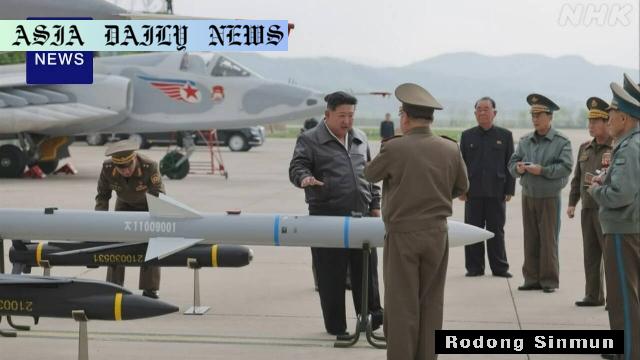North Korea’s military drills highlight advanced air combat strategies.
- Kim Jong Un oversees advanced anti-air combat drills.
- Focus on countering drones and cruise missile threats.
- North Korea tests new precision-guided glide bomb.
- Demonstrations of strategic and multi-purpose drones.
- Aim to improve soldiers’ combat experience amid international tensions.

North Korea’s Vision for Military Strength
On Thursday, North Korean leader Kim Jong Un took center stage yet again, unveiling a series of military advancements through closely monitored air combat and air raid drills. In his latest push for military supremacy, Kim underscored the urgency of enhancing war preparedness and conducting methodical readiness operations. The ruling Workers’ Party newspaper, Rodong Sinmun, highlighted the leader’s vision for a ‘radical turn’ that could redefine North Korea’s defensive strategy.
These drills, which included the testing of a new long-range precision-guided glide bomb and advanced reconnaissance drones, showcased Nort Korea’s willingness to innovate in the face of international challenges. The scope of the exercises extended to countering cruise missiles and what are referred to as ‘suicide drones,’ signaling confidence in defending against increasingly sophisticated threats. It was evident from the demonstrations—jets firing missiles and helicopters targeting drones—that North Korea aimed to highlight its expanding military prowess.
Technological Advancements in Tactical Warfare
The developments revealed at the drills point to strategic enhancements in both offensive and defensive operations. A significant spotlight was placed on drones, seen as critical to future combat scenarios. From multi-purpose drones to strategic reconnaissance models, these devices are being rendered indispensable for real-time intelligence gathering and tactical flexibility. Coupled with long-range glide bombs, they have strengthened North Korea’s ability to operate in diverse combat situations.
Moreover, the testing of precision-guided weaponry is indicative of a broader strategy—deterrence through modernity. Guided weapons offer improved accuracy and lethality, allowing North Korean forces to target high-value or strategic enemy positions with reduced collateral damage. In an era where military strength is as much about readiness as it is precision, these advancements may serve as a warning to adversaries in the region.
Interpreting North Korea’s Military Display
The broader implications of this exercise are complex, resonating far beyond the Korean Peninsula. South Korean and international analysts have interpreted the drills as part of a larger strategy to gain technical and combat experience. A notable point of interest involves the speculated involvement of North Korean soldiers dispatched to Russia, possibly gaining firsthand insights during the ongoing conflict in Ukraine.
For neighboring nations, this spectacle raises questions about North Korea’s long-term intentions. By investing in drone technologies and missile capabilities amidst geopolitical tensions, Pyongyang seems intent on conveying its relevance on the global stage. Equally, it is a message to potential adversaries: the North is ready to defend its sovereignty at all costs.
Against this backdrop, the drills could also be interpreted as a morale booster for North Korea’s armed forces. Demonstrating sophisticated weaponry and orchestrated drills serves to unify the ranks and foster a sense of invincibility—a key psychological component in any military-ready policy.
The Road Ahead for Global Relations
North Korea’s military demonstrations invariably alter the calculus not only for allies like China and Russia but also for adversaries, notably South Korea, Japan, and the United States. The focus on new-age warfare like drone combat highlights an increasing global shift toward unmanned, tech-heavy battlefields. However, these advancements should be understood within the spectrum of North Korea’s limited resources and global isolation, which could impede ambitious long-term strategies.
Ultimately, North Korea’s focus on such exercises might lay the groundwork for future diplomatic negotiations or heighten tensions depending on how its actions are interpreted. The ability to project power—even in demonstrations—remains a hallmark of North Korea’s strategic playbook.



Commentary
A Broader Perspective on North Korea’s Military Push
North Korea’s recent military drills bring several important issues into focus—chief among them, its determination to consolidate defensive capabilities and establish itself as a major player within a globally competitive military arena. At the heart of these displays is the theme of resilience and innovation, both of which are inextricably tied to the nation’s survival narrative amidst international sanctions and political isolation. Kim Jong Un’s rhetoric of effecting a ‘radical turn’ signals an unwavering commitment to power projection as a means to ensure not only sovereignty but also leverage in diplomatic negotiations.
The Implications of Technological Warfare
There’s an undeniable trend in North Korea’s military advancements—a shift toward technologies that underscore precision and versatility. From reconnaissance drones to advanced missiles, these assets—while expensive—fluidly integrate into modern combat scenarios. In a context like North Korea’s, where every technological investment must deliver disproportionate results given resource constraints, the ongoing focus on drones and precision weaponry reflects a strategic prioritization of key areas that could shift regional power dynamics.
The Global Context
However, the exercises must be evaluated within the broader geopolitical context. For regional players like South Korea and Japan, such drills are bound to generate anxiety and elevate calls for countermeasures. Modern military investments have become a barometer for escalated or de-escalated tensions, particularly in Asia. Yet, conversely, for non-regional entities like the United States, North Korea’s demonstrations likely serve as a reminder of the complexities of global containment strategies.
Overall, North Korea’s intensified focus on tech-driven warfare has escalated its military ambitions to an attention-grabbing level. While its immediate readiness and geopolitical impact remain points of debate, its persistent innovation and forward-looking strategies testify to its intent to remain relevant on the world stage.